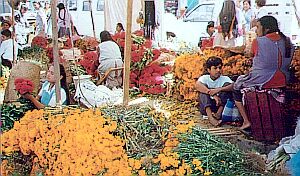
|
 |
"It's 5.0 at the Caseta de Cambio (money changer) in Cinco de Mayo Street". "Yesterday I got 5.6 at Banco Serfin". "According to 'The News' (an English language newspaper printed in Mexico City), it was 5.9 yesterday". "My black market guy says it will be 5.4 by tomorrow".
The price of a dollar, in "New" Mexican pesos: the subject of conflicting rumors, desperate hopes, tragic disappointment and endless guessing games. As each day dawns with a new rate, fortunes are made and lost. People who would never buy a lottery ticket or invest in Wall Street have become speculators in peso futures.
I have been here a little over a year. In that time, the Mexican government has issued a "new" peso, and a new "new" peso. The new peso replaced the old peso by shaving three zeros: ten thousand pesos was, by the magic of the printing press, changed to ten pesos. The new new peso, issued some months later, has new pictures and smaller bills, and for some denominations there now are both bills and coins. A short-changer's paradise, made less dangerous by the honesty and patience of the vast majority of Mexican business people.
Around the end of 1994, a new element was introduced into this already confusing situation: under tremendous pressures from foreign currency speculators such as the U.S. Treasury, the big lending banks and Daddy Warbucks (good night Orphan Annie, whoever you are), the Mexican government allowed the Peso to "float".
The immediate result was a tremendous increase in hospitalization for whiplash, as everyone closely watched the ups and downs of the peso. If you doubt that all money is funny, follow the bouncing peso as it goes from 5.0 to 6.4 one day and from 6.8 to 7.2 to 5.8 the next. Or, for a dandy migraine, try to figure out why it's 7.2 in Mexico City Airport, 6.9 in Mexico City, 5.8 in Oaxaca and 5.6 on the beach -- all at the same time.
Prescription for the Peso Blues: take a couple of Aspirin, go to bed, and check the rate in the morning...
Whether you are dancing in the streets or selling pencils from a tin cup in the Zócalo (town square) in the spring of 1995, depends upon how you hold your savings. If you hold dollars (cash or travelers checks), you have about 100 percent more buying power than you had in November. If you held it in Pesos, it was about half gone by April Fools' day 1995. If you use an ATM card, it's jackpot city: the highest rates are those paid by the central bank in Mexico City, and all computerized transactions (including credit cards) go through the central bank. Happy hour for months in Mexico: two for one. Of course, if you are Mexican, you are screwed: like always...
See, Mexicans still get paid in pesos. That means that the things that take dollars to buy, like toaster ovens and televisions, became twice as expensive during the first quarter of 1995. That includes air fares, conferences and cultural exchanges in the U.S., batteries for your portable radio, and numerous other imported items. So, I can just hear you saying, they'll have to adjust their lifestyle to do without some of those luxury items. And, even assuming that you wouldn't mind doing the same (wouldn't you?), that's just the beginning.
There's also taxes and inflation. President Billy's little loan package (which amounted to just enough to make the interest payments on then-current debt, so it was really a loan to his banker friends, get it?) had some very serious strings attached. Starting in March, shortly after the "loan" was approved, the Mexican government began to act, calling for "austerity measures" of the sort which impact those least able to afford them. For example, a 50% "interim" increase in the "value added tax", a sales tax by another name, and a 35% increase in gasoline prices. Has anyone forgotten that the Mexicans had to pledge the next 10 years' profits from Pemex, the national oil company, to get the "loan"? Or that the VAST majority of Pemex's sales are to its' own citizens? Bus fares went up 40%, and Electricity by 25%.
Official government predictions released in February projected 20% inflation in 1995 (it was 4.5% in 1994). This was amended to 45% in March. By May 1995, the projected inflation rate was 70%. Nearly one million Mexican workers are said to have lost their jobs in the first three months of 1995, but that was only the first wave of a giant recession that is coming: the result of taxing away the ability of the Mexican people to buy more than three squares and a flop.
And here's a little "trickle-up" question for you: When Mexicans can no longer afford any extras, what happens to all those U.S. workers who make goods for export to Mexico (our second biggest trading partner)? So let's get to the bottom line, folks: if you think this "loan" package is designed to do anything positive for anyone but the international banking community, and a few well placed Mexican politicians and their profiteer buddies -- try taking another look at it.
(April, 1995)
| "Letters From Oaxaca, México" | "The Oaxaca / México Newsletter" | Diana's Photo Album | Free Advice |
| Other Interesting Websites | Give Us A Piece of Your Mind | Orientation To Oaxaca | Frequently Asked Questions |